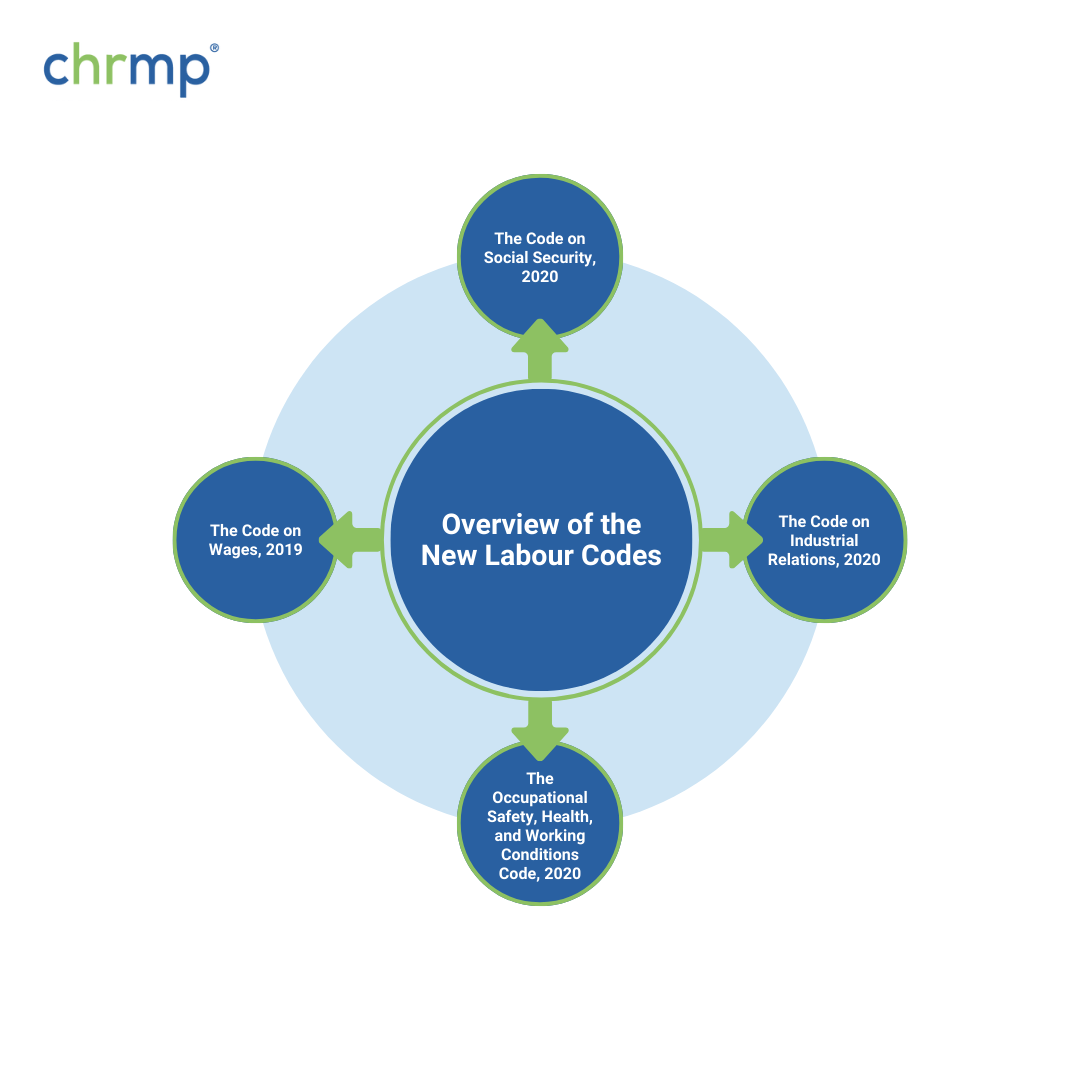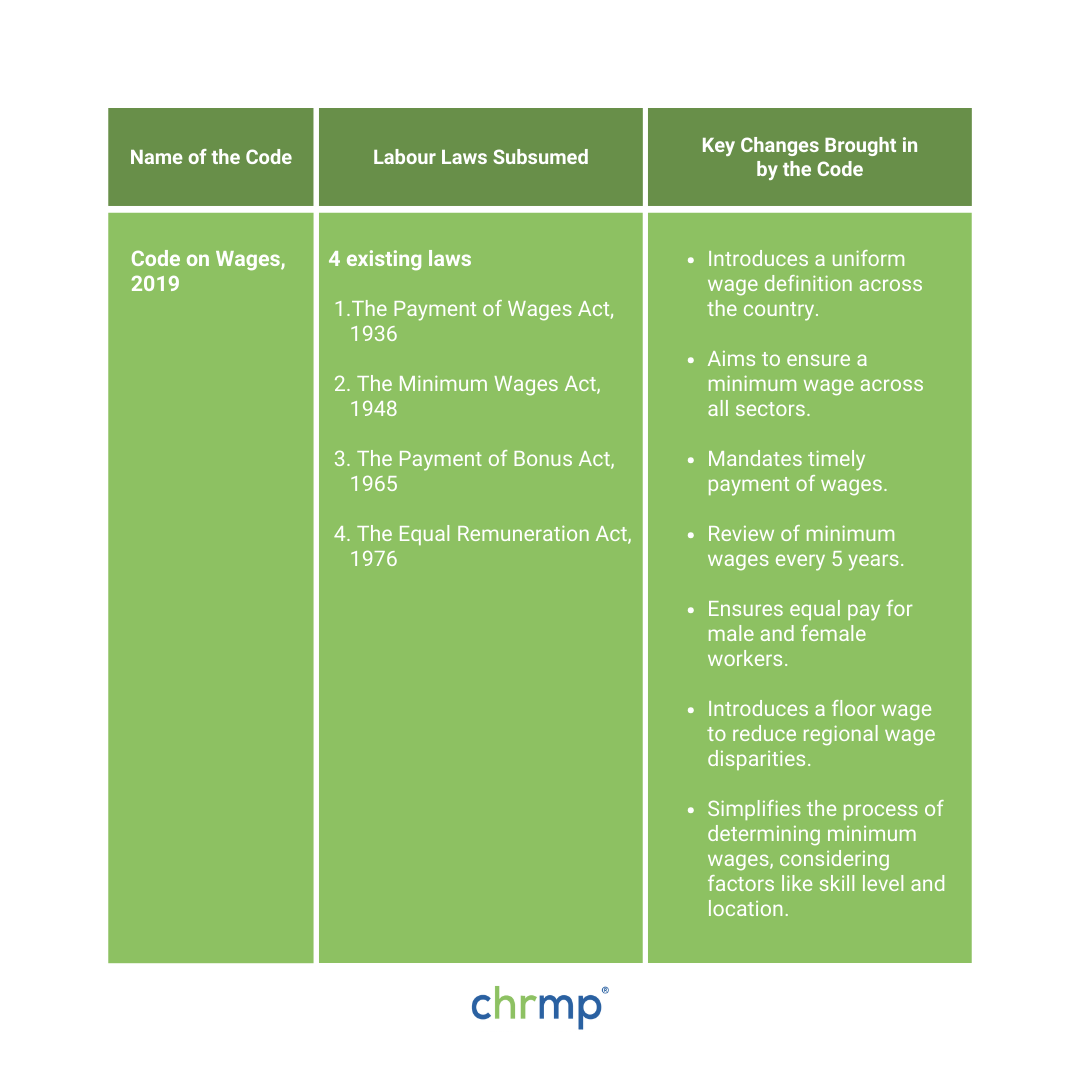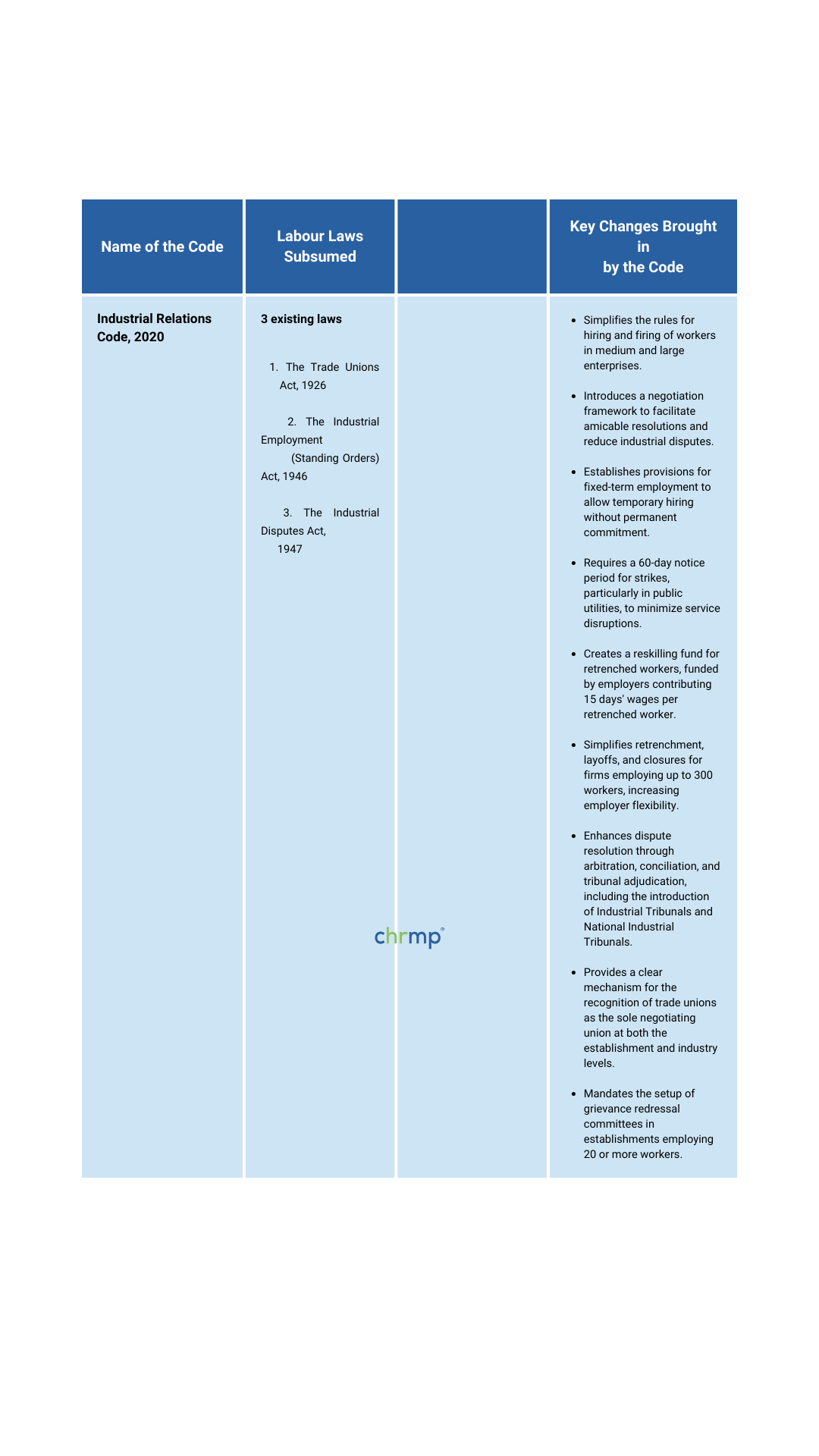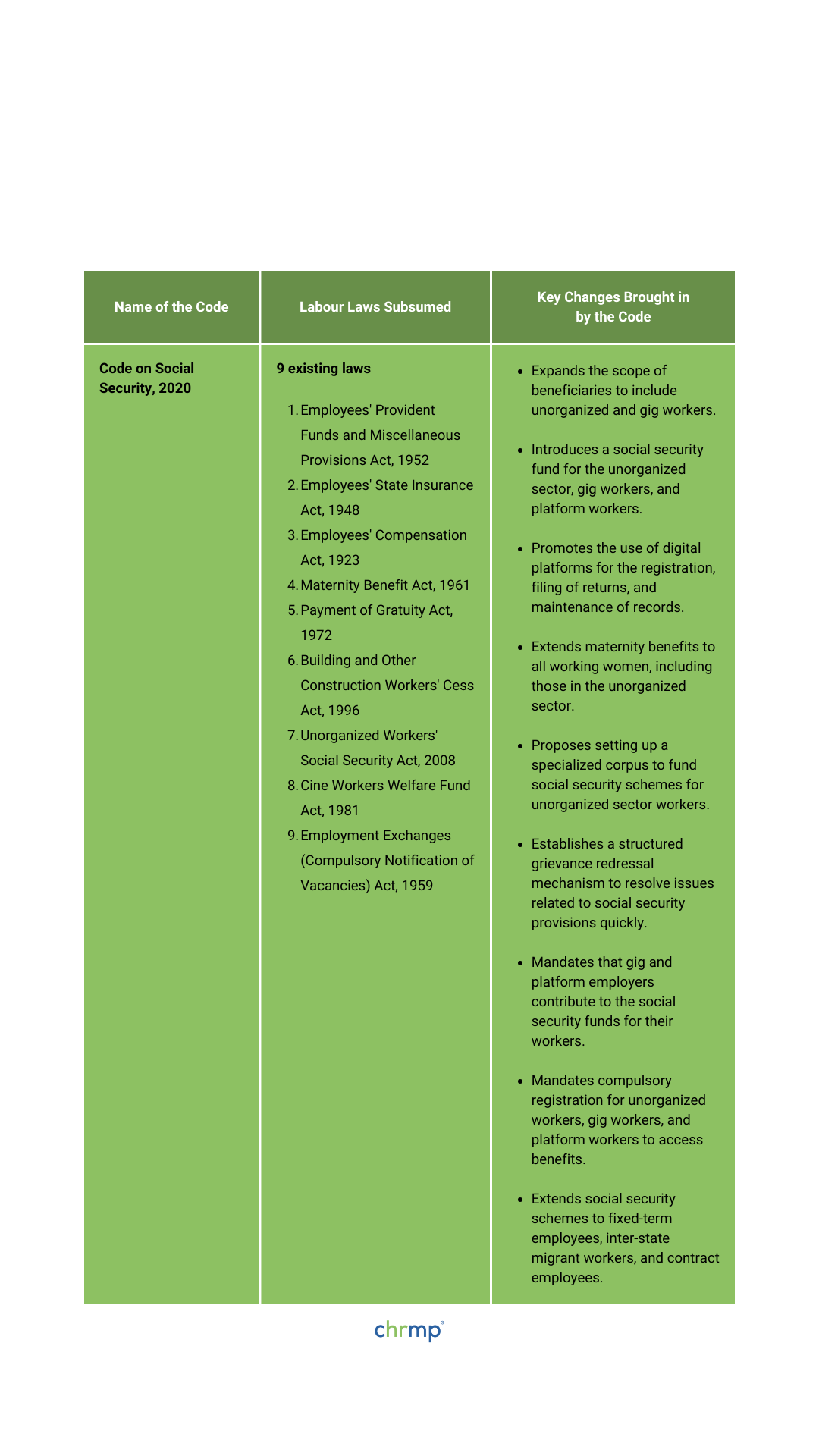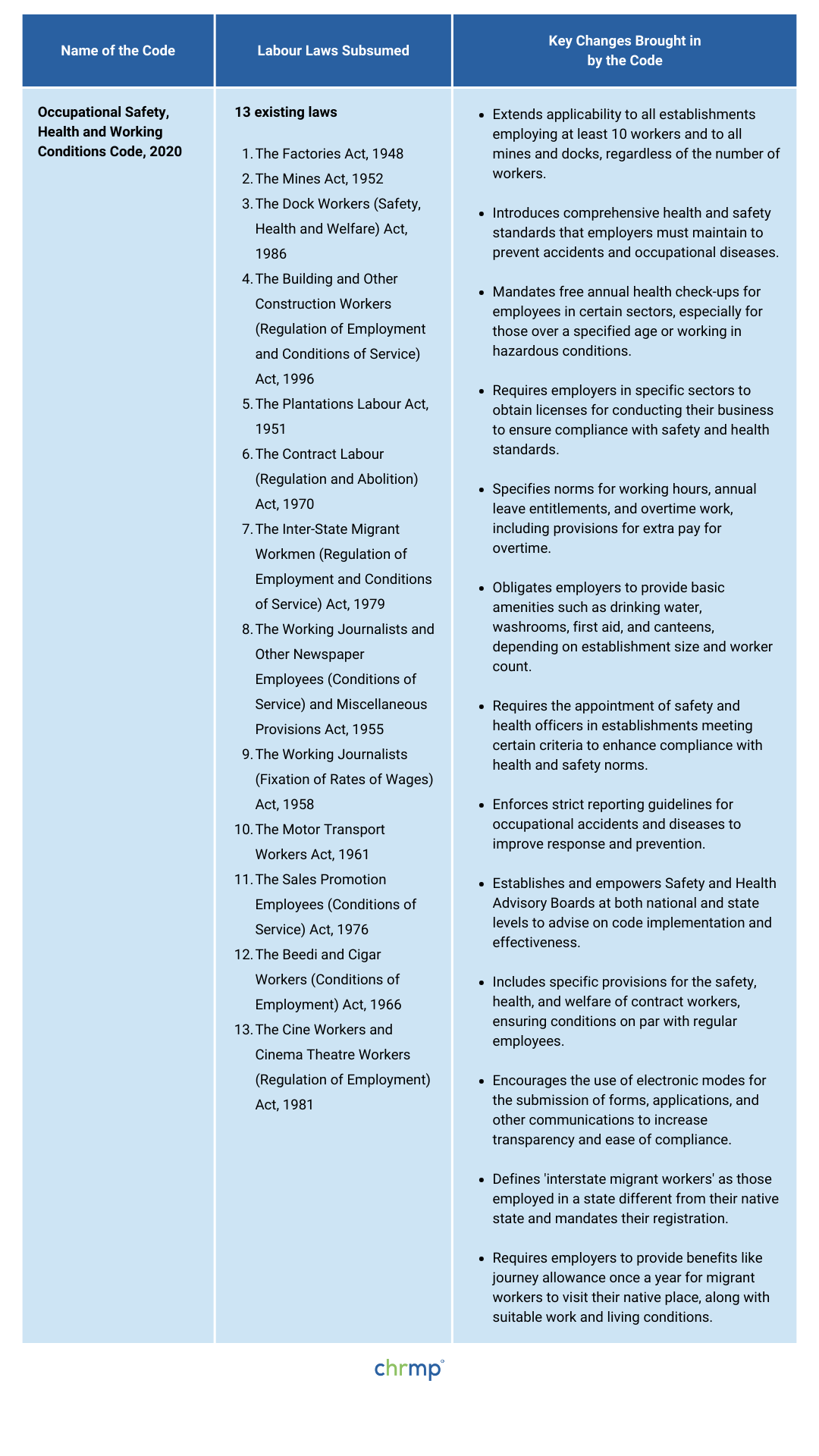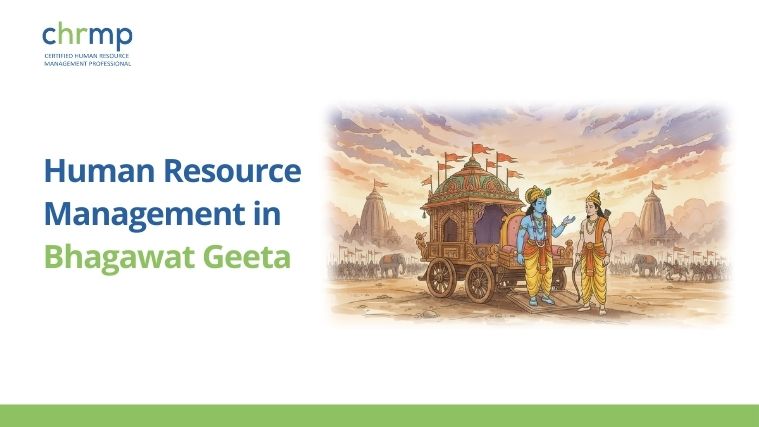With India’s economy evolving rapidly and the four new labour codes impacting over 50 crore workers across various sectors, it’s crucial for HR professionals and business leaders to grasp these changes. This blog aims to provide a comprehensive comparative analysis between the new labour codes and the traditional labour laws, highlighting the impact, benefits, and challenges associated with the new framework.
By the end of this blog, you’ll gain valuable insights into the implications of these changes and practical advice for ensuring compliance.
What are Labour Laws ?
Labour laws refer to a set of legal regulations and provisions that govern the rights, responsibilities, and relationships between employers, employees, and labor unions in the workplace. These laws are designed to ensure fair treatment, safety, and protection of workers’ rights. They cover various aspects of employment, including wages, working hours, working conditions, benefits, occupational health and safety, discrimination, termination, and industrial relations.
In India, there were over 40 central labor laws governing various aspects of employment. Additionally, each state in India may also have its own set of labor laws and regulations, which can further add to the total number.
What are Labour Codes?
Labour codes, on the other hand, are comprehensive pieces of legislation that consolidate and streamline various existing labour laws into a single, cohesive framework. These codes aim to simplify and modernize the legal framework governing labor relations, making it easier for both employers and employees to understand and comply with their rights and obligations.
In many countries, including India, there has been a trend towards consolidating and updating labour laws into a smaller number of comprehensive codes. These codes typically cover areas such as wages, industrial relations, social security, occupational safety and health, and working conditions. The consolidation of laws into codes helps in improving ease of doing business, enhancing compliance, and promoting a more conducive environment for both employers and employees.
The government has merged 29 out of the 44 existing central labor laws into these four comprehensive labor codes:
- The Code on Wages, 2019
- The Code on Social Security, 2020
- The Industrial Relations Code, 2020
- The Occupational Safety, Health, and Working Conditions Code, 2020
Historical Context and Evolution of Labour Laws in India
India’s labour laws have evolved over decades, originating during the British colonial period. Initially, these laws aimed to address the needs of an industrializing economy and protect workers’ rights. Post-independence, numerous labour laws were introduced, resulting in a complex web of regulations that often overlapped and conflicted.
Evolution of Labour Laws
- Pre-Independence: The foundation of labour laws in India was laid during the British era with acts like the Trade Disputes Act, 1929, and the Payment of Wages Act, 1936.
- Post-Independence: The introduction of the Industrial Disputes Act, 1947, and the Factories Act, 1948, marked significant developments. However, over time, the proliferation of laws created a complex regulatory environment.
- Economic Liberalization: The 1990s saw India opening up its economy, necessitating labour reforms to attract investment and enhance competitiveness.
- 21st Century: The push for consolidating labour laws gained momentum, driven by the need to simplify compliance and address the changing dynamics of the workforce.
The Need for Labour Codes
India’s transition from a complex web of fragmented labour laws to a streamlined set of four comprehensive labour codes represents a major shift in the legal landscape governing employment and industrial relations. Here’s a detailed exploration of why these new labour codes were necessary:
- Historical Fragmentation and Complexity
India’s labour laws had evolved over decades, resulting in a patchwork of over 40 statutes. These laws were often overlapping, inconsistent, and difficult to navigate for both employers and employees.
- Economic Liberalization and Modern Workforce Needs
India’s economic landscape has undergone substantial changes since the liberalization of the economy in the 1990s. The traditional labour laws were not equipped to handle the demands of a rapidly modernizing economy.
- Promoting Ease of Doing Business
To attract investment and promote economic growth, it was imperative to create a business-friendly environment. Simplifying and modernizing labour laws was a critical step towards achieving this goal.
- Enhancing Worker Protection and Rights
The new labour codes also address the need for better protection of workers’ rights and improved working conditions.
- Responding to Global Standards
As India integrates more with the global economy, aligning its labour laws with international standards becomes crucial.
The Need for Labour Codes
 Overview of Overview of the New Labour Codes
Overview of Overview of the New Labour Codes
Overview of the New Labour Codes
The four new labour codes aim to consolidate and simplify India’s labour laws into a coherent framework. These are:
The Code on Wages, 2019
The creation of the Code on Wages, 2019, was driven by the need to streamline and modernize India’s complex and fragmented wage-related labour laws. Historically, wage regulation in India was governed by multiple legislations, each addressing specific aspects of wage payment, minimum wages, bonus distribution, and gender-based wage equality.
This fragmented approach often led to inconsistencies, administrative burdens, and enforcement challenges. The Indian government recognized the necessity for a more cohesive and comprehensive framework to ensure fair and uniform wage practices across all sectors.
Objectives and Benefits:
The primary objectives of the Code on Wages are:
- To establish a consistent wage structure across sectors.
- To ensure the timely payment of wages to all employees, regardless of their sector.
The Code on Industrial Relations, 2020
The Code on Industrial Relations, 2020, represents a significant overhaul of India’s industrial relations framework, aiming to streamline and modernize the process of collective bargaining, dispute resolution, and trade union activities.
Prior to the enactment of this code, industrial relations in India were governed by multiple legislations, leading to complexity and inconsistency in the regulatory landscape.
Objectives and Benefits:
The primary objectives of the Code on Industrial Relations are:
- To promote collective bargaining.
- To facilitate the formation and functioning of trade unions.
- To provide a structured mechanism for resolving industrial disputes.
The Code on Social Security, 2020
The enactment of the Code on Social Security, 2020, was prompted by the imperative to revamp and modernize India’s social security system, which was previously governed by a patchwork of laws.
These laws addressed various aspects of social security, including provident funds, insurance, and welfare measures, resulting in a fragmented and sometimes inequitable framework.
Objectives and Benefits:
The primary objectives of The Code on Social Security, 2020 are:
- To extend social security benefits to all workers, including those in the unorganized sector.
- To simplify administration of social security schemes.
The Occupational Safety, Health, and Working Conditions Code, 2020
The Occupational Safety, Health, and Working Conditions Code, 2020, emerged from the imperative to modernize and enhance workplace safety and welfare standards across India. Previously, regulations governing occupational safety and health were dispersed across various laws, leading to challenges in enforcement and compliance.
Objectives and Benefits:
The objectives of the Occupational Safety, Health, and Working Conditions Code are:
- To ensure a safe and healthy working environment.
- To improve overall working conditions and enforce compliance with safety regulations.

Detailed Comparison between Labour Codes and Labour Laws in India(need the table designed simply)
The following are the detailed differences between Labour Codes and Labour Laws in India
Significant Changes: Enhancements and Drawbacks
-
Enhancements:
- One-stop Registration: Simplified process where businesses register once for all necessary licenses.
- Unified Licensing: Single application to obtain all required licenses .
- Consolidated Reporting: Submission of one comprehensive statement covering all regulatory requirements.
- Minimal Documentation: Reduction in paperwork by minimizing the number of forms needed.
- Standardized Definitions: Clarity and consistency by using common definitions across regulations.
- Reduction in number of Committees: Streamlined decision-making processes by minimizing the number of committees involved.
- Digital Inspections: Inspections conducted efficiently through web-based platforms, reducing surprises and enhancing transparency.
- Technological Integration: Electronic registration and licensing systems implemented to leverage technology for seamless processes.
- Cost Reduction: Compliance costs minimised for businesses and reduction of the likelihood of disputes through streamlined procedures.
-
Drawbacks:
- Transition Challenges: Transitioning from old laws to new codes may pose implementation challenges, requiring time and resources for adaptation and compliance.
- Enforcement Issues: Despite streamlining enforcement mechanisms, ensuring strict compliance with the new codes may still be challenging, particularly in sectors with weak regulatory oversight.
- Potential Resistance: Some stakeholders, including employers and trade unions, may resist changes introduced by the new codes, leading to friction and resistance during implementation.
Practical Advice for Businesses to Ensure Full Compliance
- Conduct a Compliance Audit:
- Review current practices and policies to identify gaps between existing procedures and the new requirements. Conducting a thorough audit will help businesses understand the areas needing adjustment.
- Update Employment Contracts and Policies:
- Revise employment contracts, wage structures, and workplace policies to align with the new codes. Ensure that definitions, terms, and conditions are consistent with the standardized definitions and guidelines provided by the codes.
- Train HR and Compliance Teams:
- Invest in training for HR and compliance teams to familiarize them with the new regulations. Regular training sessions will ensure that the teams are well-equipped to handle compliance requirements effectively.
- Implement Digital Solutions:
- Adopt digital tools and software for compliance management. Digital solutions can help streamline processes, maintain accurate records, and facilitate timely reporting to authorities.
- Engage Legal and Compliance Experts:
- Consult with legal and compliance experts to ensure a comprehensive understanding of the new codes. Experts can provide valuable insights and guidance on navigating the complexities of the new regulations.
- Regular Monitoring and Review:
- Establish a system for regular monitoring and review of compliance practices. Continuous oversight will help businesses stay updated with any amendments to the codes and ensure ongoing compliance.
Future of Work: Adapting to New Work Models with the New Labour Codes
The recent overhaul of India’s labour laws through the introduction of the new labour codes is a significant stride towards modernizing the employment landscape to better align with evolving work models such as remote work, the gig economy, and freelance arrangements. These changes not only reflect the current trends but also set a framework that anticipates future shifts in the nature of work.
Adaptation to Emerging Work Models:
- Remote Work: The new labour codes provide a flexible legal framework that can accommodate the nuances of remote work. While the codes currently do not specify regulations exclusive to remote work, their adaptable nature suggests that they could be easily updated to include such provisions. This flexibility is crucial as remote work demands considerations around working hours, employee monitoring, and health and safety that differ from traditional office settings.
- Gig Economy and Freelance Work: Perhaps the most significant update in the new codes is the inclusion of gig and platform workers under the umbrella of social security benefits, as outlined in the Code on Social Security, 2020. This inclusion represents a forward-thinking approach, acknowledging the growing segment of non-traditional employment. It ensures that gig workers and freelancers have access to benefits such as healthcare, maternity benefits, and disability insurance, which were previously unavailable to them.
Future Modifications in Labour Regulations:
As the workforce and workplace continue to evolve, further modifications in labour regulations are likely to follow. Some anticipated trends and changes might include:
- Enhanced Protections for Remote Workers: Future amendments in the labour codes may introduce specific protections for remote workers, potentially addressing issues like the right to disconnect, compensation for home office setups, and guidelines for virtual employee monitoring.
- Formalization of Gig Work: Current provisions for gig workers might be expanded to include more robust contractual rights, standardized payment practices, and clearer tax obligations. This would further formalize gig work as a key component of the economy and ensure fair treatment in line with traditional employment.
- Dynamic Working Hours and Leave Policies: As work-life balance becomes a central theme in employment discussions, labour codes may evolve to offer more dynamic working hours and innovative leave policies that accommodate different life stages and personal commitments of employees.
- Regulation of Artificial Intelligence in the Workplace: With AI and automation becoming integral to business operations, future labour regulations might need to address the impact of these technologies on employment. This could include laws around AI governance, job displacement due to automation, and re-skilling programs for affected workers.
Conclusion:
In our comparative analysis of India’s traditional labour laws and the new labour codes, we’ve identified crucial improvements and potential challenges. The transformation into four streamlined codes is designed to simplify compliance, enhance transparency, and support fairer workplace practices. However, adapting to changes in areas such as contract labour, digital compliance, and grievance redressal will be pivotal.
For HR professionals and business leaders, grasping these nuances is essential. Being proactive in updating HR policies and training teams on these changes is key to ensuring seamless compliance and maintaining a positive work environment.
How prepared is your organization to meet the demands of these updated labour codes?

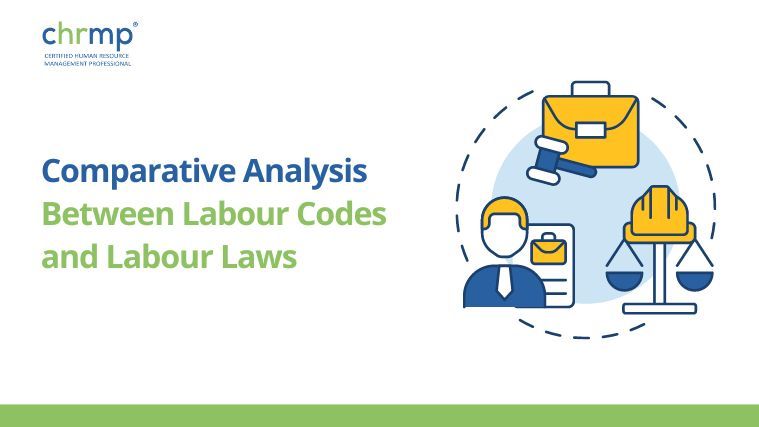
 Overview of Overview of the New Labour Codes
Overview of Overview of the New Labour Codes